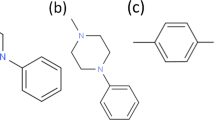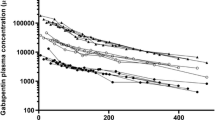Abstract
Purpose. The aim of the present study was to investigate the transport kinetics of intestinal secretory processes in the jejunum, ileum and colon of rats and humans and in Caco-2 cells, in vitro.
Methods. Etoposide, vinblastine sulphate and verapamil hydrochloride were chosen as model substrates since they have been reported to undergo efflux in various other tissues. The concentration dependence, inhibition, directionality, temperature dependence, proton/sodium dependence, and ATP dependence of efflux were studied using side-by-side diffusion chambers and brush border membrane vesicles (BBMVs). Intestinal tissue from rats and humans and Caco-2 cells (passage no. 26) were used. Directional steady state effective permeabilities were calculated from drug appearance in the apical (AP) or basolateral (BL) chambers. Kinetic studies were carried out by investigating substrate efflux at concentrations ranging from 0.2 μM to 1000 μM. Since substrate efflux may be a result of more than one transporter, the hybrid efflux Km (Michaelis-constant), Pc (carrier-mediated permeability), and Pm (passive permeability) were determined as a function of intestinal region. Inhibitor studies were performed using quinidine (0.2 mM), a mixed inhibitor of P-glycoprotein (Pgp) and Multidrug Resistance-Associated Protein (MRP), and Leukotriene C4(100 nM), an inhibitor of MRP and the canalicular multispecific organic anion transporter (cMOAT). Temperature dependent efflux was determined by investigating the BL to AP transport at temperatures ranging from 3°C to 37°C. Energies of activation (Ea) were determined from an Arrhenius analysis. Sodium, proton, and ATP dependence were determined using BBMVs. Immunoquantitation of Pgp, MRP and Lung Resistance Protein (LRP) in Caco-2 cells were carried out using Western blot analysis.
Results. Active efflux of all substrates was observed in all regions of rat and human intestine and in Caco-2 cells. Directionality was observed with BL to AP transport exceeding AP to BL transport. The BL to AP/AP to BL permeability ratio, the efflux ratio, ranged from 1.4 to 19.8. Heal efflux was significantly higher (p < 0.001) than in other regions. Kinetic studies revealed that hybrid efflux Km values ranged from 4 to 350 μM. In some cases, efflux was not saturable due to the solubility limits of the compounds utilized in this study. In presence of inhibitors, efflux ratios approached 1. BL to AP transport was temperature dependent in rat ileum for all substrates. Ea of intestinal efflux was found to be 11.6, 8.3, and 15.8 kcal/mole for etoposide, vinblastine and verapamil, respectively, suggesting an active, energy-dependent efflux mechanism. Substrate efflux was not sodium or proton dependent but was dependent on ATP. Using Western blot analysis the presence of Pgp, MRP, and LRP was demonstrated in Caco-2 cells and the amount of each transport protein varied as a function of passage number.
Conclusions. Using multiple putative efflux substrates, the current results demonstrate that intestinal efflux was regionally dependent, mediated by multiple efflux transporters, the Km’s were in the micro-molar range, and involved an energy dependent mechanism(s).
Similar content being viewed by others
REFERENCES
G. D. Kruh, A. Chan, K. Myers, K. Gaughan, T. Miki, and S. A. Aaronson. Expression complementary DNA library transfer establishes mrp as a multidrug resistance gene. Cancer Res. 54:1649-1652 (1994).
S. P. C. Cole, K. E. Sparks, K. Fraser, D. W. Loe, C. E. Grant, G. M. Wilson, and R. G. Deeley. Pharmacological characterization of multidrug resistant MRP-transfected human tumor cells. Cancer Res. 54:5902-5910 (1994).
D. Schadendorf, A. Makki, C. Stahr, A. van Dyck, R. Wanner, G. L. Scheffer, M. J. Flens, R. Scheper and B. M. Henz. Membrane transport proteins associated with drug resistance expressed in human melanoma. Am. J. Pathol. 147:1545-52 (1995).
Z. C. Gatmaitan and I. M. Arias. Structure and function of P-glycoprotein in normal liver and small intestine. Advances in Pharmacology 24:77-91 (1993).
I. Sagawara, S. Akiyama, R. J. Scheper, and S. Itoyama. Lung resistance protein (LRP) expression in human normal tissues in comparison with that of MDR1 and MRP. Cancer Lett. 112:23-31 (1997).
K. Ito, H. Suzuki, T. Hirohashi, K. Kume, T. Shimizu, and Y. Sugiyama. Molecular cloning of canalicular multispecific organic anion transporter defective in EHBR Am. J Physiol. 272:G16-22 (1997).
D. Keppler, J. Konig, and M. Buchler. The canalicular multidrug resistance protein' cMRP/MRP2' a novel conjugate export pump expressed in the apical membrane of hepatocytes. Adv. Enzyme Regul. 37:321-33 (1997).
M. A. Izquierdo, G. L. Scheffer, M. J. Flens, G. Giaccone, H. J. Broxterman, C. J. Meijer, and P. van der Valk. Broad distribution of the multidrug resistance-related vault lung resistance protein in normal human tissues and tumors. Am. J. Pathol. 148:877-87 (1996).
L. Z. Benet, C.-Y. Wu, M. F. Hebert, and V. J. Wacher. Intestinal drug metabolism and antitransport processes: A potential paradigm shift in oral drug delivery. J Contr. Rel. 39:139-143 (1996).
L. C. Floren, I. Bekersky, L. Z. Benet, Q. Mekki, D. Dressler, J. W. Lee, J. P. Roberts, and M. F. Hebert. Tacrolimus oral bioavailability doubles with coadministration of ketoconazole. Clin. Pharmacol. Ther. 62:41-9 (1997).
J. Alsenz, H. Steffen, and R. Alex. Active apical secretory efflux of the HIV protease inhibitors saquinavir and ritonavir in Caco-2 cells monolayers. Pharm. Res. 15:423-(1998).
J. Hunter and B. H. Hirst. Intestinal secretion of drugs. The role of P-glycoprotein and related drug efflux systems in limiting oral drug absorption. Adv. Drug Delivery Rev. 25:129-157 (1997).
B. L. Leu and J. D. Huang. Inhibition of intestinal P-glycoprotein and effects on etoposide absorption. Cancer Chemother. Pharmacol. 35:432-436(1995).
J. Hunter, M. A. Jepson, T. Tsuruo, N. L. Simmons, and B. H. Hirst. Functional expression of P-glycoprotein in apical membranes of human intestinal Caco-2 cells. Kinetics of vinblastine secretion and interaction with modulators. J. Biol. Chem. 268:14991-14997 (1993).
H. Saitoh, and B. J. Aungst. Possible involvement of multiple P-glycoprotein-mediated efflux systems in the transport of verappamil and other organic cations across rat intestine. Pharm. Res. 12:1304-1310 (1995).
R. B. Kim, M. F. Fromm, C. Wandel, B. Leake, A. J. J. Wood, D. M. Roden, and G. R. Wilkinson. The Drug Transporter P-glycoprotein limits oral absorption and brain entry of HIV-1 Protease Inhibitors. J. Clin. Invest. 101:289-294 (1998).
D. W. Loe, K. C. Almquist, R. G. Deeley, and S. P. C. Cole. Multidrug resistance protein (MRP)-mediated transport of Leukotriene C4and chemotherapeutic agents in membrane vesicles. J. Biol. Chem. 271:9675-9682 (1996).
I. Leier, G. Jedlitschky, U. Buchholz, S. P. C. Cole, R. G. Deeley, and D. Keppler. The MRP gene encodes an ATP-dependent export pump for Leukotriene C4and structurally related conjugates. J. Biol. Chem. 269:27807-27810 (1994).
A. P. Waclawski and P. J. Sinko. Oral Absorption of Anti-AIDS Nucleoside Analogues. 2. Carrier-Mediated Absorption of Stavudine in Rat and Rabbit Preparations. J. Pharm. Sci. 85:478-485 (1996).
M. Donowitz, E. Emmer, J. McCullen, L. Reinlib, M. E. Cohen, R. P. Rood, J. Madara, G. W. G. Sharp, H. Muer, and K. Malmstrom. Freeze-thaw and high voltage discharge allow macromolecule uptake into ileal brush-border vesicles. Am. J. Physiol. 252:G273-G735 (1987).
S. Hsing, Z. Gatmaitan, and I. M. Arias. The Function of Gp170, the Multidrug-Resistance Gene Product, in the Brush Border of Rat Intestinal Mucosa. Gastroenterology 102:879-885 (1992).
Laemmli, U. K. Cleavage of structural proteins during the assembly of the head of bacteriophage T4. Nature (Lond.) 227:680-685 (1970).
Flens, M. J., Izquierdo, M. A., Scheffer, G. L., Fritz, J. M., Meijer, C. J. L. M., Scheper, R. J., and Zaman, G. J. R. Immunochemical detection of the multidrug resistance-associated protein MRP in human multidrug-resistant tumor cells by monoclonal antibodies. Cancer Res. 54:4557-4563 (1994).
M. Muller, H. Roelofsen, and P. L. Jansen. Secretion of organic anions by hepatocytes: involvement of homologues of the multidrug resistance protein. Semin Liver. Dis. 16:211-20 (1996).
T. Terao, E. Hisabaga, Y. Sai, I. Tamai, and A. Tsuji. Active secretion of drugs from the small intestinal epithelium in rats by P-glycoprotein functioning as an absorption barrier J. Pharm. Pharmacol. 48:1083-1089 (1996).
H. Saitoh, C. Gerard, and B. J. Aungst. The secretory intestinal transport of some beta-lactam antibiotics and anionic compounds. J. Pharmacol. Exp. Ther. 278:205-211 (1996).
P. A. Augustijns, T. Timothy, P. Bradshaw, L-S. L. Gan, R. W. Hendren, and D. R. Thakker. Evidence for a polarized efflux system in Caco-2 cells capable of modulating cyclosporin A transport. Biochem. Biophys. Res. Commun. 197:360-365 (1993).
J. Karlsson, S. M. Kuo, J. Ziemniak, and P. Artursson. Transport of celiprolol across human intestinal epithelial (Caco-2) cells: mediation of secretion by multiple transporters including P-glycoprotein. Br. J. Pharmacol. 110:1009-1016 (1993). See also: S. M. Kuo, B. R. Whitby, P. Artursson, and J. A. Ziemniak. The contribution of intestinal secretion to the dose-dependent absorption of celiprolol. Pharm. Res. 11:648–653 (1994).
P. S. Burton, R. A. Conradi, A. R. Hilgers, and N. H. Ho. Evidence for a polarized efflux system for peptides in the apical membrane of Caco-2 cells. Biochem. Biophys. Res. Commun. 190:760-766 (1993).
P. Wils, V. Phung-Ba, A. Warnery, D. Lechardeur, S. Raeissi, I. J. Hidalgo, and D. Scherman. Polarized transport of docetaxel and vinblastine mediated by P-glycoprotein in human intestinal epithelial cell monolayers. Biochem. Pharmacol. 48:1528-1530 (1994).
M. E. Cavet, M. West, and N. L. Simmons. Transport and epithelial secretion of the cardiac glycoside, digoxin by human intestinal epithelial (Caco-2) cells. Br. J. Pharmacol. 118:1389-1396 (1996).
S. Paul, L. M. Breuninger, K. D. Tew, H. Shen, and G. D. Kruh. ATP-dependent uptake of natural product cytotoxic drugs by membrane vesicles establishes MRP as a broad specificity transporter. Proc. Natl. Acad. Sci.USA 93:6929-6934 (1996).
I. J. Hidalgo and R. T. Borchardt. Transport of a large neutral amino acid (phenylalanine) in a human intestinal epithelial cell line: Caco-2. Biochim. Biophys. Acta. 1028:25-30 (1990).
K. Goda, L. Balkay, T. Marian, L. Tron, A. Aszalos, and G. Szabo Jr. Intracellular pH does not affect drug extrusion by P-glycoprotein. J. Photochem. Photobiol. B. 34:177-82 (1996).
Ken-ichi, Hosoya, K.-J. Kim, and V. H. L. Lee. Age-dependent expression of P-glycoprotein gp170 in Caco-2 cell monolayers. Pharm. Res. 13:885-890 (1996).
S. F. Su, J. D. Huang. Inhibition of the intestinal digoxin absorption and exsorption by quinidine. Drug Metab. Dispos. 24:142-7 (1996).
A. H. Schinkel, J. J. Smit, O. van Tellingen, J. H. Beijnen, E. Wagenaar, L. van Deemter et. al. Disruption of the mouse mdr la P-glycoprtoein gene leads to a deficiency in the blood-brain barrier and to increased sensitivity to drugs. Cell. 77:491-502 (1994).
A. H. Schinkel, E. Wagenaar, C. A. Mol and L. van Deemter. P-glycoprotein in the blood-brain barrier of mice influences the brain penetration and pharmacological activity of many drugs. J. Clin. Invest. 97:2517-2524 (1996).
Author information
Authors and Affiliations
Rights and permissions
About this article
Cite this article
Makhey, V.D., Guo, A., Norris, D.A. et al. Characterization of the Regional Intestinal Kinetics of Drug Efflux in Rat and Human Intestine and in Caco-2 Cells. Pharm Res 15, 1160–1167 (1998). https://doi.org/10.1023/A:1011971303880
Issue Date:
DOI: https://doi.org/10.1023/A:1011971303880




